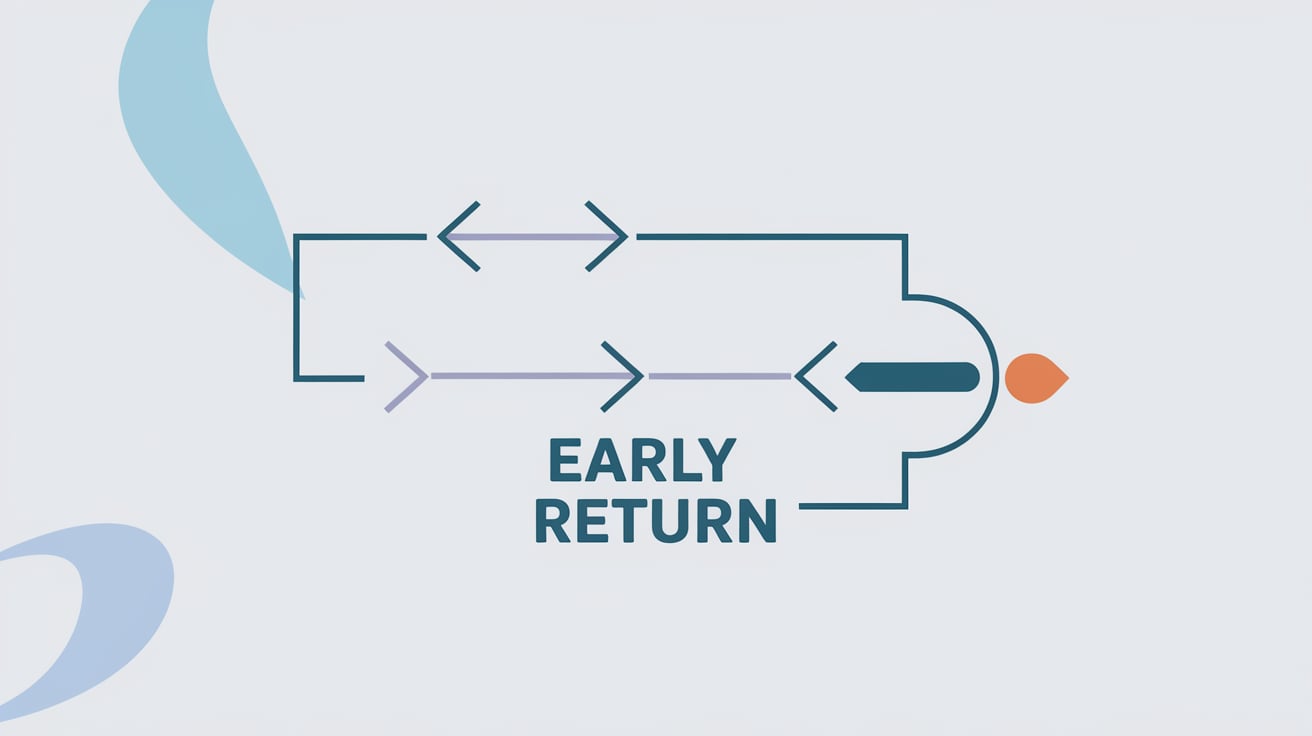Friday, 29. November 2024
Early Return - The Most Simple Pattern for Better Maintainability

In my first year as a professional back-end developer, I learned a lot—from mastering the basics to diving into more advanced topics. I’ll admit, I’ve probably forgotten at least half of what I learned. But there’s one pattern that has stuck with me and consistently proves its value: The early return pattern. This simple yet powerful technique has been a game-changer for writing code that’s both maintainable and easy to understand.
The Problem
I think all developers have been there: We write functions or methods that become increasingly nested
as we try to handle edge cases or error conditions.
While it might feel like the logical way to structure the code with if statements at first,
nested code can quickly become a nightmare to maintain.
Here’s why:
- Reduced Readability: As conditions stack up and statements become more and more nested, it becomes harder for anyone (including our future selves) to understand the flow of logic.
- Increased Complexity: More indentation means more chances for mistakes, as we might miss handling a specific case or misunderstand a condition.
-
Difficult Debugging: When things go wrong, finding the issue becomes trickier
when the logic is buried deep inside multiple layers of
ifstatements orelseblocks.
In short, the more nested the code gets, the more difficult it is to read, test, and maintain. This is where the early return pattern comes into play.
What is the Early Return Pattern?
The early return pattern is a coding technique that helps simplify functions or methods by handling invalid or edge cases upfront, allowing the main logic to remain clear and uncluttered. By returning early when a condition isn't met, we eliminate the need for deep nesting, making the code easier to read and maintain.
Here’s how it works in practice: Instead of checking for all conditions in nested if
statements and leaving the main logic at the deepest level, we "return early" when an
invalid condition is met. This eliminates the need for nesting and else blocks.
Why should we use it?
- Cleaner, Readable Code: Handle edge cases early and keep the main logic simple.
- Less Risk of Errors: Fewer nested conditions mean fewer places where bugs can hide.
- Improved Maintainability: With fewer layers of logic, the code becomes much easier to modify or extend in the future.
Let's dive into some examples to see the early return pattern in action. I use PHP for the examples, but you can literally use the early return pattern in any language, I would say.
Example 1 - Authorization Middleware
Middleware is a great place to use early returns, especially when we need to check authorization or roles. Without the early return, the code might look like this:
public function handle(Request $request, Closure $next)
{
if (auth()->check()) {
if (auth()->user()->role == 'admin') {
// Proceed with the request
return $next($request);
} else {
return response()->json(['error' => 'Unauthorized'], 403);
}
}
return response()->json(['error' => 'Unauthorized'], 403);
}
This approach has a lot of unnecessary nesting. With early returns, we can clean it up:
public function handle(Request $request, Closure $next)
{
if (! auth()->check() || auth()->user()->role !== 'admin') {
return response()->json(['error' => 'Unauthorized'], 403);
}
return $next($request);
}
Now, the logic is more straightforward and easy to follow. We return early if the user is not authorized, and the rest of the code executes cleanly only if everything passes.
Example 2: Simplifying Business Logic in Services
The second example is for processing an order in a dedicated service class, where we need to handle various conditions.
Without early returns:
public function processOrder(Order $order)
{
if ($order->status == 'pending') {
if ($order->product->stock > 0) {
if ($this->chargePayment($order)) {
$order->update(['status' => 'processed']);
} else {
return false; // Payment failed
}
} else {
return false; // Out of stock
}
}
return false; // Invalid order status
}
Puh, this looks not good. Let's clean this up by using the early return attern.
public function processOrder(Order $order)
{
if ($order->status !== 'pending') {
return false; // Only process pending orders
}
if ($order->product->stock <= 0) {
return false; // Out of stock
}
if (! $this->chargePayment($order)) {
return false; // Payment failed
}
$order->update(['status' => 'processed']);
return true;
}
The early return pattern allows the main logic to focus on the core actions (charging payment, updating status) while handling all edge cases upfront.
Conclusion
The early return pattern is an incredibly simple yet powerful technique for writing clean, maintainable, and easy-to-read code. By handling invalid conditions or edge cases early in functions or methods, we keep our main logic clean and avoid nesting.
In my opinion, it is one of the easiest patterns to wrap your head around and it's incredibly simple to implement. I use it everywhere and it makes my code so much more readable.
What about you? Have you known about the early return pattern already? If you have some experience, I bet you do. But even if not, don’t feel bad about it—now you know how to use it and can start implementing it in your code.
Happy coding, and see you next time!
Comments
Login or Register to write comments and like posts.